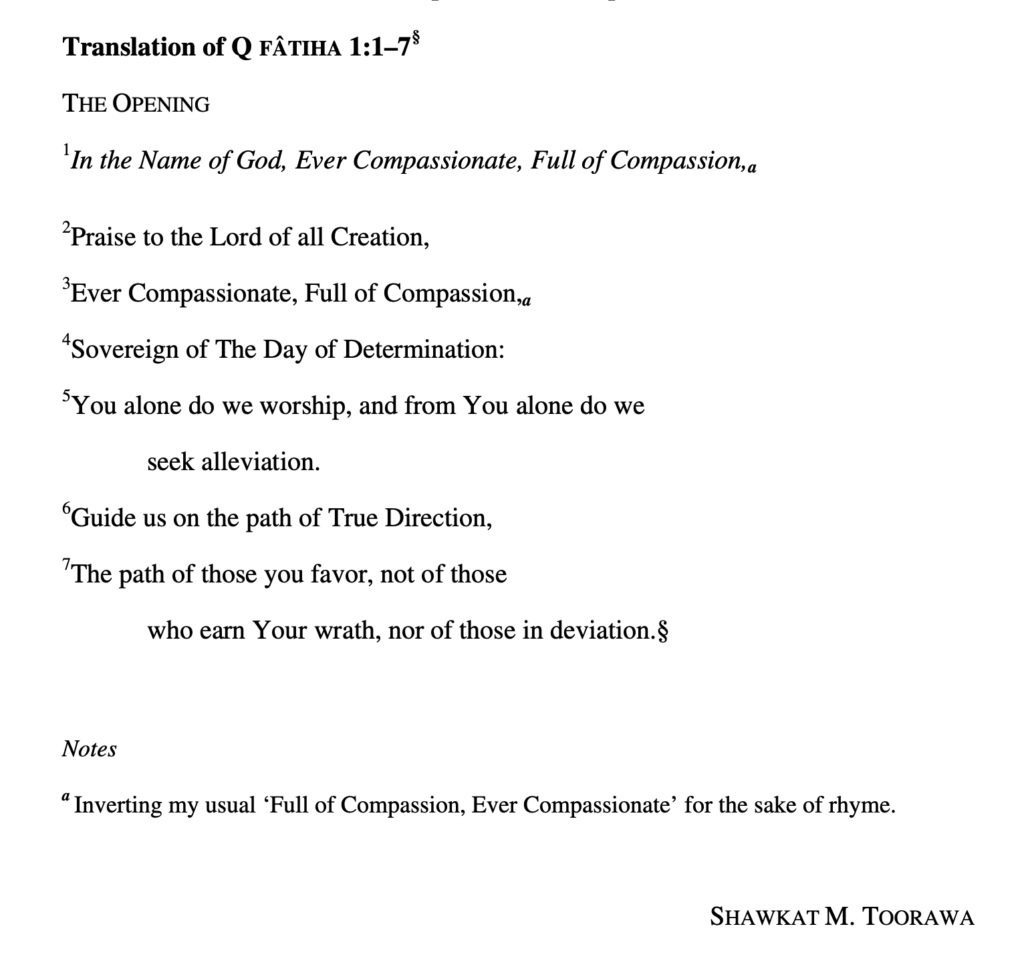The Qur’an is “not the word of a poet” but aspects of structure, rhythm and rhyme certainly evoke aspects of Arabic poetry. Can any of that carry over into translation? Should it?
Shawkat Toorawa is Professor of Arabic at Yale, and his approach to teaching and translating the Qur’an draws from his broader interests in literature. He pays special attention to the Qur’anic lexicon (including hapaxes, rare words, and rhyme). His ongoing translations, published mainly in journal articles, make the unusual attempt (but not entirely without precedent) to convey non-semantic features of the Qur’anic text through English rhyming prose. All can be accessed via Toorawa’s website:
https://shawkutis.weebly.com/translations.html
Naturally, Toorawa selected Meccan suras, particularly shorter ones with shorter verses, many of which appear at the end of the compiled Qur’an. He started with Surat al-Insan (Q 76) after hearing it in the Prophet’s Mosque (Medina) and being struck by its uncommon words. He then translated Ya-Sin (Q 36), then the last 22 suras, before turning his focus to Surat al-Rahman (Q 55). Attached is his rendering of the Fatiha (Q 1).
The first suras to be published at length were in “‘The Inimitable Rose’, being Qur’anic sajʿ from Sūrat al-Ḍuḥā to Sūrat al-Nās (Q. 93–114) in English Rhyming Prose” (JQS, 2007). In composing his English rhymes and other sound features, Toorawa is following patterns in the Arabic. For example, in al-Ḍuḥā, he uses the “-ight” (and similar) in place of the sura’s /-ā/, and “-ess” for /-ar/. We can understand the purpose as being to convey some of the effects of the Qur’anic sounds and their alternations, which, along with its meanings, are how its message is delivered. It may well be the case that some semantic precision is sacrificed to achieve this.
The next article (“Referencing the Qur’an”) contains Q 1, 36 & 76. Brief notes describe the translation process, linguistic observations and other clarifications. One note seems to conflate the forms kāfūr and kafūr while noting they have different meanings: “camphor/unbeliever”. Some surprising translation choices would benefit from some explanation, such as 36:68, which Toorawa renders: “Someone We’ve allowed to grow old, We can make ageless” (nunakkis-hu fī ’l-khalq, typically “we reverse in creation”, etc.).
The next article takes a broader look at “Sūrat Maryam (Q. 19): Lexicon, Lexical Echoes, English Translation” and presents his own analysis in conversation with secondary literature, before applying his observations to the translation. Another presents Q 55 along with Q 87 and 90. He had earlier noted how repetition in Surat al-Rahman “aroused aversion in Nöldeke” but was “explicated with finesse by Angelika Neuwirth and M.A.S. Abdel Haleem” as key to its literary style and effect. This was followed by separate articles with Surat al-Tariq (Q 86) and al-Ghashiya (Q 88); the last, published in 2015, gives a detailed description of the translator’s process. Attached is one draft figure along with the final version.
Shawkat Toorawa’s project is valuable in multiple ways, not least in that it fights for aspects of the Qur’an that are typically accepted to be lost in translation. His generosity in detailing his thought process should inspire future efforts from a variety of approaches.
Toorawa’s translation of Surat al-Kahf (Q 18) has just been published in JQS:
https://www.euppublishing.com/doi/abs/10.3366/jqs.2021.0453
Sohaib Saeed


